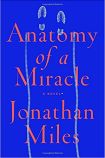Anatomy of a Miracle by Jonathan Miles
Look closely at the cover of Jonathan Miles's third novel and you'll see the central drama depicted: white wheelchair tracks snake up from the bottom and stop three-quarters of the way from the top, where they are replaced by footprints. On 23 August 2014, wheelchair-bound veteran Cameron Harris stands up and walks outside the Biz-E-Bee convenience store in Biloxi, Mississippi. In the rest of the novel, we find out how he got to this point and what others – ranging from his doctor to representatives of the Roman Catholic Church – will make of his recovery. Was it a miracle, or an explainable medical phenomenon?
| Anatomy of a Miracle by Jonathan Miles | |
|
| |
| Category: Literary Fiction | |
| Reviewer: Rebecca Foster | |
| Summary: A paralyzed, wheelchair-bound veteran stands up and walks. Is it a miracle, or an explainable medical phenomenon? Miles has been rather sly in how he's packaged this. On the title page, he calls it a 'True Story', and the style is reminiscent of journalistic reportage. But he made it all up. Some may feel tricked – which would be a shame, as there are interesting questions of faith and science that would be rewarding for a book club to discuss. | |
| Buy? Maybe | Borrow? Yes |
| Pages: 352 | Date: March 2018 |
| Publisher: Bantam USA | |
| External links: Author's website | |
| ISBN: 9780553447583 | |
|
| |
Cameron was paralyzed from the waist down by a land mine in Afghanistan in 2010. He lives with his older sister, Tanya; their father left early on, and their mother died in a car accident when Cameron was 16. Hurricane Katrina devastated their community. Ninety-one-year-old Eula Dooley only survived it by sheltering in a fridge. She is the first witness of the apparent miracle of Cameron walking, and soon asks him to pray for her troubled grandson – proof that he's already become something of a modern-day saint whom people believe can intercede with God on their behalf.
Tanya posts to Facebook a photograph of Cameron standing up and gets nearly 800 comments, many of them religious affirmations along the lines of 'Hallelujah' or 'Amen' – but also one from a Sun Herald reporter. Cameron himself is rather bemused by all the attention. He celebrates his first steps with a beer. Now, though still unsteady on his feet after years of muscle atrophy, he can get around using crutches. When the reporter presses him, he admits that yes, he thinks what happened to him was a miracle, and God must have another plan in mind for him. But with so many different influences around him, it grows increasingly unclear what that might be.
The Catholic Church considers it its duty to prove a miracle has taken place. They send a Vatican investigator, Euclide Gianni Abbascia, to interview those who knew Cameron before his injury. At the other end of the spectrum is Cameron's doctor, Janice Lorimar-Cuevas, who is committed to reasoning things out. Scans show her patient really was paralyzed, but experienced spinal cord regrowth between 2010 and 2012. Still, this degree of recovery is unprecedented. Scenes in which Janice discusses Cameron's case with colleagues are particularly good, with faultless medical lingo. A third faction grappling over Cameron's story is the media, represented by a reality television producer whose plan is to make a one-hour documentary that balloons into a whole series, Miracle Man.
We learn more about the backstory of most of Miles's characters, including Cameron's war service and how the Vietnamese proprietors of the Biz-E-Bee mart escaped their home country. I especially liked hearing about Dr Janice's upbringing with an eccentric Southern author for a father. Winston Lorimar was a teller of tall tales, whereas Janice is completely dedicated to finding objective truth. Their conversation towards the end of the novel is one of the highlights for me. Winston dismisses the facile contrasts the world sets up between faith and reason, imagination and evidence: 'it's too easy, now, to overstate these as competing aims. It's a common and rather toxic form of glibness. Because what they are, see, they're just parallel routes to the same place … Consolation.'
Miles has been rather sly in how he's packaged this. On the title page, he calls it a 'True Story', but an asterisk qualifies that with the phrase 'a novel'. The style, reminiscent of journalistic reportage, is like what Dave Eggers uses in nonfiction books such as Zeitoun. The author keeps up the pretence of the whole thing being based on interviews with the key players, all the way through to the acknowledgements. But early on I did an Internet search for information on a war veteran named Cameron Harris and found nothing. He made it all up.
Miles's previous novel, Want Not, is the book I most wish I'd written, so it was perhaps inevitable this one would suffer in comparison. Janice and Winston were my favourite characters; I never particularly warmed to Cameron or Tanya, who never fully outgrow the country bumpkin stereotype. I suspect some will feel tricked by how Miles tells his story and may resent being tricked. That would be a shame, as there are interesting questions here that would be rewarding for a book club to discuss (admittedly, an American group might be more invested in the religious theme). What is the relationship between science and storytelling? How can we identify 'God's will'? As the truth about Cameron's sexuality emerges, we are also asked to contrast it with paralysis and ask which 'condition' is changeable. An intriguing if troubling read.
Further reading suggestions: Zeitoun by Dave Eggers, The Yellow Birds by Kevin Powers and Desperation Road by Michael Farris Smith.
Please share on: ![]() Facebook,
Facebook, ![]() Twitter and
Twitter and
![]() Instagram
Instagram
![]() You can read more book reviews or buy Anatomy of a Miracle by Jonathan Miles at Amazon.co.uk Amazon currently charges £2.99 for standard delivery for orders under £20, over which delivery is free.
You can read more book reviews or buy Anatomy of a Miracle by Jonathan Miles at Amazon.co.uk Amazon currently charges £2.99 for standard delivery for orders under £20, over which delivery is free.
![]() You can read more book reviews or buy Anatomy of a Miracle by Jonathan Miles at Amazon.com.
You can read more book reviews or buy Anatomy of a Miracle by Jonathan Miles at Amazon.com.
Comments
Like to comment on this review?
Just send us an email and we'll put the best up on the site.

